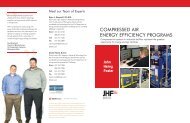The Turbo Air® 3000 Centrifugal Compressor Compressor Handbook
The Turbo Air® 3000 Centrifugal Compressor Compressor Handbook
The Turbo Air® 3000 Centrifugal Compressor Compressor Handbook
Create successful ePaper yourself
Turn your PDF publications into a flip-book with our unique Google optimized e-Paper software.
<strong>The</strong> <strong>Turbo</strong> Air <strong>3000</strong> <strong>Centrifugal</strong> <strong>Compressor</strong> Operator’s Manual<br />
Piping Material<br />
While corrosion on the discharge air side does not present the same problem as it does on the intake<br />
air piping, it is still a concern. Rust can damage delicate instrumentation, pneumatic tools, or processes<br />
that require non-contaminated air.<br />
<strong>The</strong> principal consideration in the selection of piping materials should be safety. <strong>The</strong> United States,<br />
Canada, and most other countries strictly prohibit the use of unprotected polyvinyl chloride<br />
(PVC) piping to transport compressed air or other compressed gases. Cooper <strong>Turbo</strong>compressor also<br />
advises against using soldered copper fittings and rubber hoses in discharge air piping. If fabricating<br />
the air piping with flexible joints and flexlines, be sure that they meet the operating parameters of the<br />
system.<br />
Cooper <strong>Turbo</strong>compressor recommends that all pressure-holding pipe be in accordance with the standards<br />
established by the American National Standards Institute (ANSI) as well as the American Society<br />
of Mechanical Engineers’ (ASME) Standard B31.8-1986.<br />
A—14<br />
WARNING:<br />
Be certain to follow all specified requirements and guidelines. Failure to correctly follow<br />
the above or other specified discharge air piping design guidelines will cause compressor<br />
malfunction and/or damage.<br />
Drains<br />
<strong>The</strong> high pressure air leaving the compressor contains some moisture. <strong>The</strong>refore, it is necessary to<br />
provide drains at all low points to remove any condensate that may collect along the discharge system.<br />
Fabrication<br />
<strong>The</strong> high pressures, long piping runs, and heavy accessories in the discharge air line makes design<br />
considerations necessarily more detailed than with the intake air lines. When fabricating the discharge<br />
piping system, do not exceed specified pipe volumes (0.1% of design flow in cubic feet<br />
per minute) between the compressor discharge flange, the blow-off valve, and the discharge<br />
check valve. (Additional information about blow-off valve and check valve installation is included later<br />
in this appendix.)<br />
WARNING:<br />
Do not exceed the 400 lb. (1700 Nm) Maximum Allowable Force or the Maximum Allowable<br />
moment of 600 lbs. (800 Nm) on the compressor discharge connection. Excess weight<br />
may cause pipe connection failure.<br />
Depending on the control method utilized, the pressure-sensing lines should be located either before<br />
and/or after the check valve. Refer to the Flow Schematic and Installation Arrangement drawings<br />
supplied separately for specific placement.<br />
With all control methods, it is necessary to keep the pipe volume between the compressor discharge<br />
connection, the discharge check valve, and the blow-off or bypass valve minimal. For proper operation<br />
of the discharge check valve, 18” (450mm) of straight piping should precede and follow the valve.



